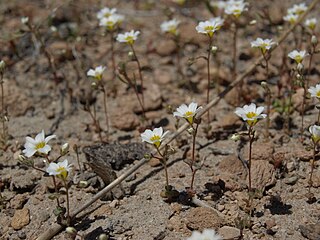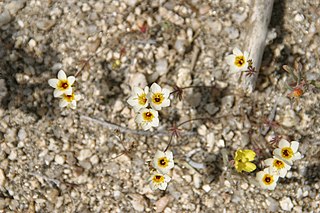Leptosiphon ambiguus, the serpentine linanthus, is a low annual plant with needle-like leaves and a vivid lavender flower. It grows in serpentine soils and is an endemic threatened species of the Bay Area in California.

Linanthus inyoensis is a species of flowering plant in the phlox family known by the common name Inyo gilia.

Leptosiphon acicularis is a species of flowering plant in the phlox family known by the common names bristly linanthus and bristly leptosiphon.

Leptosiphon androsaceus is a species of flowering plant in the phlox family known by the common name false babystars.
Linanthus bellus is an uncommon species of flowering plant in the phlox family known by the common name desertbeauty. It is known only from northern Baja California and eastern San Diego County, California, where it grows in high desert chaparral in sandy soils. This is a petite annual herb producing short, threadlike stems lined with occasional tiny needle-lobed leaves. The inflorescence is usually a single tiny flower with bright pink lobes no more than a centimeter across. The flower has a yellow throat with purple spots.

Linanthus bigelovii is a species of flowering plant in the phlox family known by the common name Bigelow's linanthus. It is native to the southwestern United States and northern Mexico where it grows mainly in dry habitat, such as the Sonoran and Mojave Deserts. This is an annual herb producing a thin stem up to about 20 centimetres tall. The leaves are linear in shape to needle-like and unlobed, measuring 1 to 3 centimetres long. The inflorescence is a small array of white flowers with lobes just under a centimetre long, and black centres. They are sometimes lavender-tinted and open in the evening.

Leptosiphon breviculus is a species of flowering plant in the phlox family known by the common name Mojave linanthus. It is endemic to California, where it is known from the Mojave Desert and dry spots in the adjacent Transverse Ranges.

Leptosiphon ciliatus is a species of flowering plant in the phlox family known by the common name whiskerbrush.

Linanthus dianthiflorus is a species of flowering plant in the phlox family known by the common names fringed linanthus and ground pink.
Leptosiphon filipes is a species of flowering plant in the phlox family known by the common name thread linanthus.
Linanthus killipii, known by the common name Baldwin Lake linanthus, is a rare species of flowering plant in the phlox family.

Leptosiphon lemmonii is a species of flowering plant in the phlox family known by the common name Lemmon's linanthus.

Leptosiphon montanus is a species of flowering plant in the phlox family known by the common name mustang clover.
Leptosiphon nudatus is a species of flowering plant in the phlox family known by the common name Tehachapi linanthus.

Leptosiphon nuttallii is a species of flowering plant in the phlox family known by the common name Nuttall's linanthus.
Leptosiphon oblanceolatus is a species of flowering plant in the phlox family known by the common name Sierra Nevada linanthus.
Linanthus orcuttii is an uncommon species of flowering plant in the phlox family known by the common name Orcutt's linanthus. It is known only from southern California and Baja California, where it grows in chaparral and pine forests in the Peninsular Ranges and occasionally the San Bernardino Mountains.

Linanthus parryae is a species of flowering plant in the phlox family known by the common name sandblossoms. It is native to the western United States, growing in states including Oregon, Idaho, Wyoming, California, Nevada, Arizona, New Mexico, and Colorado. In California, it grows in several regions from the Central Valley to the Sierra Nevada foothills and the Mojave Desert. It occurs in sandy, open, flat areas. This is a petite annual herb producing short stems just a few centimeters tall surrounded by hairy, needle-lobed leaves. The inflorescence, which often appears to sit directly on the ground tucked amidst the leaves, is a cluster of funnel-shaped flowers about a centimeter wide. The flowers are self-incompatible and are cross-pollinated exclusively by a Melyrid beetle, Trichochorous sp. Seeds germinate after winter rains in January to February, producing flowering plants in April and shedding seeds in May to June. Seeds are passively dispersed and remain viable for at least seven years, with no germination in dry years. The flowers on a plant may be white or blue. Flower color is mainly controlled by a single gene locus, with the allele for white flowers being recessive and the alleles of the blue flower being of the dominant type. Most populations have predominantly white flowers, with some populations mainly blue flowers, and some others with both blue and white flowered plants occurring at intermediate frequencies. The proportions of each color remain quite stable over time and in some locations there are sharp transitions from blue to white flowered populations. This uncommon phenomenon has made this species a model organism in studies of genetic variation.

Leptosiphon parviflorus is a species of flowering plant in the phlox family known by the common name variable linanthus.

Conradina grandiflora is a species of flowering plant in the mint family known by the common name largeflower false rosemary, or large-flowered rosemary. It is endemic to Florida in the United States, where it occurs on the Atlantic coastal ridge. Its distribution spans Brevard, Broward, Dade, Highlands, Indian River, Martin, Osceola, Palm Beach, Polk, St. Lucie, and Volusia Counties.
This page is based on this
Wikipedia article Text is available under the
CC BY-SA 4.0 license; additional terms may apply.
Images, videos and audio are available under their respective licenses.













